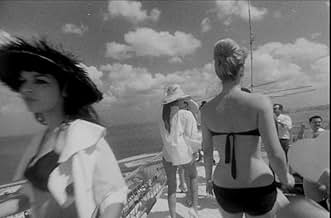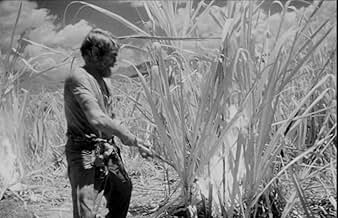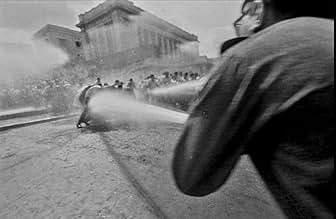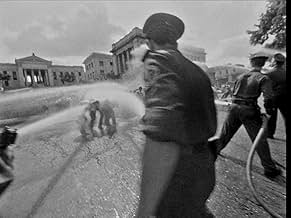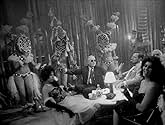Soy Cuba
- 1964
- Tous publics
- 2h 21m
Four vignettes about the lives of the Cuban people set during the pre-revolutionary era.Four vignettes about the lives of the Cuban people set during the pre-revolutionary era.Four vignettes about the lives of the Cuban people set during the pre-revolutionary era.
- Director
- Writers
- Stars
- Awards
- 2 wins & 1 nomination total
Mario González Broche
- Pablo
- (as Mario González)
- Director
- Writers
- All cast & crew
- Production, box office & more at IMDbPro
Featured reviews
Every frame of this film deserves to be printed, framed and hung in a gallery. And the sound, wow. The sound... Crunchy super-intimate sounds- like the sound of machetes ringing in the cane field- are as evocative as the images.
1964. It's amazing how much can be done with so little...
1964. It's amazing how much can be done with so little...
Just about every comment posted here eulogises Soy Cuba's camera-work, which is certainly understandable as it is remarkably filmed, but this is done to the neglect of other extremely important aspects. Whether they are bigger fans of the camera-work or of the direction, however, all the commentators on these pages seem to share the caveat that arguably the main point of the film - its plot - amounts to nothing more than "silly propaganda" or a curiosity of totalitarian film making. Such an attitude is a terrible oversight! Soy Cuba is about people's desire for freedom and a better life, and the revolutionary potential of this desire when conditions reach a point beyond which people will no longer endure. It is about self respect, and courage, will and humanity and a human, filial patriotism; it is about the distillation of Cuba as an idea and a cause for justice and empowerment. I cannot understand how deeply postmodern and jaded, or just plain superficial, someone has to be to notice all the nuances of angle and light and completely miss the deep emotional and spiriual poetry of the content (in fact, the US government certainly paid good attention, for it banned the film until 1992)! It is like discussing Korda's portrait of Che Guevara in terms of focus and aperture alone!Did they not feel goosebumps as they watched the scene of the students on the steps, and the dead dove? I am lost for words! Indeed, if it were just a vapid propaganda piece, what explains its de facto censorship in the Soviet Union? I am quite sure that many of these commentators must have visited the Caribbean on holiday at one time or another; I know from my own experiences, and they ought to have immediately realised on seeing the film, that the portrait the it paints of Cuba remains the reality of Jamaica, Dominican Republic, Haiti today, some 65 years later. Watching this film, we should above all feel indignant, rather than heaping praise onto disembodied and decontextualised technicalities such as camera-work. To dismiss it as propaganda yet ogle at its images is akin to prostituting this beautiful, very deeply moving, and inspiring film, the same way that Cuba herself was prostituted. Shame on you.
One of the advantages of making a propaganda film in communist countries is that you have full support of the government that you are favoring. With that in mind, it's no wonder that a film of this magnitude could be made only in a communist country (before it went bankrupt). Soy Cuba surprises the viewer over and over again as you expect the camera to cut, and just as you expect it to, it doesn't and whoosh, you're underwater, or you've just flown out a window and hover above a funeral procession of massive proportions. I ponder the planning it must have taken to concoct such long takes with each moment so thoughtfully planned out. As much as most people will credit this film with fabulous cinematography (which it arguably has), it is a direct result of the complex direction by Mikheil Kalatozishvili that gives the film its flow and strength. Long takes become boring if the rhythm of the film is not well choreographed (some Tarkovsky films have this problem, but not all). Soy Cuba is never boring. Of course, what is most interesting is to see Havana in all it's beauty just after Fidel's revolution and then to contrast that with the Cuba seen in Buena Vista Social Club. It says it all about the politics of this film. This one is purely worth watching for the choreography and cinematography, not for the silly ideology. This is required viewing for all filmmakers.
No less than thirty shots have been ripped off from this movie in the past five years, in films like Out of Sight, Boogie Nights, and Pulp Fiction. Watching "I Am Cuba" is an education in film technique and the beauty of the eponymous country. The picture's plot is abysmal. It is an exercise in cinematography. It is among the most influential movies, style-wise, that the American public has never seen and honestly brilliant on all terms.
Imagine taking a tour of Cuba, in 1964, through the eyes of four metaphors: luxury, poverty, revolution, and vagrancy. Times are changing, the country is changing. However, no matter how much anything changes, the sun-soaked gorgeousness of the land doesn't budge. The camera glides around like a member of the tour who has gone off on his own, looking at the four principles.
I Am Cuba is film that needs no hyperbole. It Is Great
Imagine taking a tour of Cuba, in 1964, through the eyes of four metaphors: luxury, poverty, revolution, and vagrancy. Times are changing, the country is changing. However, no matter how much anything changes, the sun-soaked gorgeousness of the land doesn't budge. The camera glides around like a member of the tour who has gone off on his own, looking at the four principles.
I Am Cuba is film that needs no hyperbole. It Is Great
I had no idea what this film was about or when it was shot when I watched it. About an hour & a half into it I realized that I was mesmerized. I was weary from not blinking while I watched silently and then realized that I'd not moved from the moment of that first long shot from the party atop the hotel, which wound through the crowd into a pool below.
Somewhere during the cabal in the night-club where we watched a young woman dancing disconcertingly and harnessed, I became riveted. Then as we watched her being followed home through a ghetto by a man from the club I felt like a voyeur, which worked through the end of that story and melded seamlessly into the next.
It is a story starting at night as a young woman is approached and intimidated by a bunch of US Sailors and another clean cut Cuban student comes to her aid. Still I was feeling like I was just inside a window somewhere watching these people who might turn and look up to spot me at any moment. So I remained still and quiet through almost the entire film, and continued following the student and watching his attempts at assassination and his friends' deaths because they "doth protest too much".
Then I'm standing just behind a farmer melancholy in his doorway remembering... thinking as his grown children sleep just nearby. They all wake to work the land with their father. The images are starkly bright whites sliced by black shards of shadows and shapes that make up the surrounding overgrown land, buildings, people and that lone horse. I realize my stillness when my hypnosis is broken by the landowner riding up to tell the crushed old man that the land has been sold. He feigns being OK by sending his kids off to town to enjoy some sodas and music, for all their hard work. Then he burns their home to the ground.
I think it is here that I take my first breath in 90 minutes -I exhale. Then the next think you know, I'm hiding and watching again, this time in the mountains and a guerrilla, who at first seems lost, lands on the doorstep of a small rural family with at least one child running around bare bottom. Everyone here looks weary and dirty, the soldier also, who is invited in to eat. As he eats the wife crushes corn in the background like the rhythm of a snare to the smoky voice of a jazz singer as the soldier speaks of revolution. The father strangely can't take this kind of aggressive thinking and has the guerrilla to leave. Just as I try to inhale, a bomb hits just next to the little raggedy house in the hills and the family makes a hasty retreat, but father and son get separated from mother and children. It's dangerous and sad, serious and almost silent. The little naked boy who retreated with his agonizing father gets killed. Father is reunited with his family under a cave-side waterfall. Pain, loss, grief, anger - he goes to join the revolutionaries in a final act of leaving his little family behind.
Now I've watched the entire film and I'm still not sure how I feel about it all, but I'm breathing again, and I continue to live with the images.
That is a good film experience.
Somewhere during the cabal in the night-club where we watched a young woman dancing disconcertingly and harnessed, I became riveted. Then as we watched her being followed home through a ghetto by a man from the club I felt like a voyeur, which worked through the end of that story and melded seamlessly into the next.
It is a story starting at night as a young woman is approached and intimidated by a bunch of US Sailors and another clean cut Cuban student comes to her aid. Still I was feeling like I was just inside a window somewhere watching these people who might turn and look up to spot me at any moment. So I remained still and quiet through almost the entire film, and continued following the student and watching his attempts at assassination and his friends' deaths because they "doth protest too much".
Then I'm standing just behind a farmer melancholy in his doorway remembering... thinking as his grown children sleep just nearby. They all wake to work the land with their father. The images are starkly bright whites sliced by black shards of shadows and shapes that make up the surrounding overgrown land, buildings, people and that lone horse. I realize my stillness when my hypnosis is broken by the landowner riding up to tell the crushed old man that the land has been sold. He feigns being OK by sending his kids off to town to enjoy some sodas and music, for all their hard work. Then he burns their home to the ground.
I think it is here that I take my first breath in 90 minutes -I exhale. Then the next think you know, I'm hiding and watching again, this time in the mountains and a guerrilla, who at first seems lost, lands on the doorstep of a small rural family with at least one child running around bare bottom. Everyone here looks weary and dirty, the soldier also, who is invited in to eat. As he eats the wife crushes corn in the background like the rhythm of a snare to the smoky voice of a jazz singer as the soldier speaks of revolution. The father strangely can't take this kind of aggressive thinking and has the guerrilla to leave. Just as I try to inhale, a bomb hits just next to the little raggedy house in the hills and the family makes a hasty retreat, but father and son get separated from mother and children. It's dangerous and sad, serious and almost silent. The little naked boy who retreated with his agonizing father gets killed. Father is reunited with his family under a cave-side waterfall. Pain, loss, grief, anger - he goes to join the revolutionaries in a final act of leaving his little family behind.
Now I've watched the entire film and I'm still not sure how I feel about it all, but I'm breathing again, and I continue to live with the images.
That is a good film experience.
Did you know
- TriviaThe now famous long take that begins at the top of the hotel, then winds around and down into the swimming pool, originally come out of the water and continued. The camera was hand held, passed from crew member to crew member, to make its way down the side of the hotel into the pool. The camera lens had been equipped with a high speed, spinning glass disk taken from a submarine periscope. The spinning disk was installed to fling water drops off of the lens when the camera emerged from the swimming pool at the end of the shot. Much to the disappointment of the camera crew, director Mikhail Kalatozov cut the end of the take, ending it underwater.
- GoofsWhen Enrique gets to the top of the high-rise building he gains access to the roof by stepping through a window with a broken pane of glass. When he returns, the pane in same window is unbroken.
- ConnectionsFeatured in Soy Cuba, O Mamute Siberiano (2004)
- SoundtracksLoco amor
(Spanish-speaking adaptation of the 1958 song "Crazy Love")
Music and lyrics by Paul Anka
Performed by El Duo Los Diablos (as Los Diablos Demonicos)
Added accompaniment music recorded later at the Prado 210 studio
With Chucho Valdés (piano), Guillermo Barreto (drums) and Orlando "Cachaito" Lopez (bass).
- How long is I Am Cuba?Powered by Alexa
Details
- Release date
- Countries of origin
- Official site
- Languages
- Also known as
- Je suis Cuba
- Filming locations
- Calle M & 23 Ave, Havana, Cuba(rooftop scene: Enrique as a sniper)
- Production companies
- See more company credits at IMDbPro
Box office
- Gross US & Canada
- $168,100
- Gross worldwide
- $274,098
- Runtime
- 2h 21m(141 min)
- Color
- Sound mix
- Aspect ratio
- 1.37 : 1
Contribute to this page
Suggest an edit or add missing content





